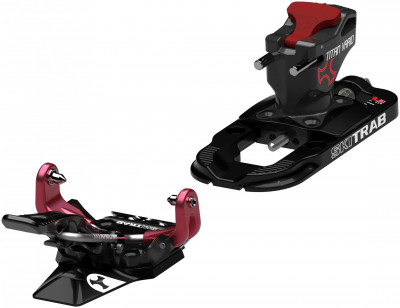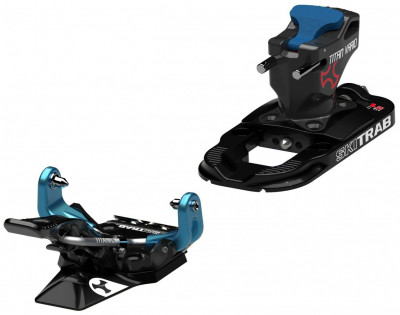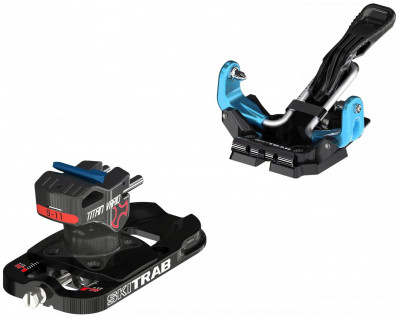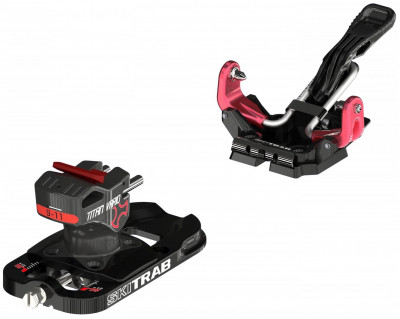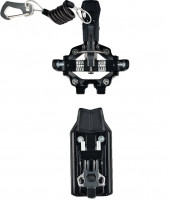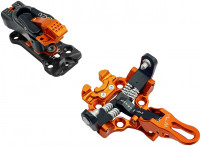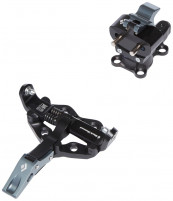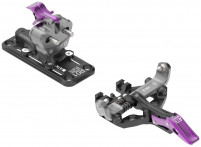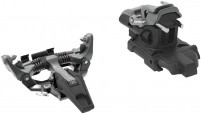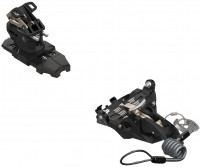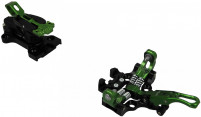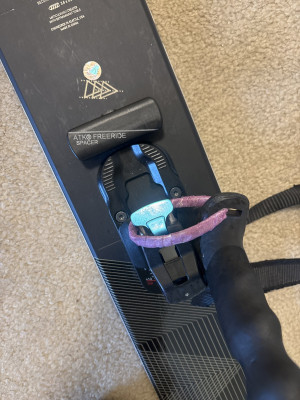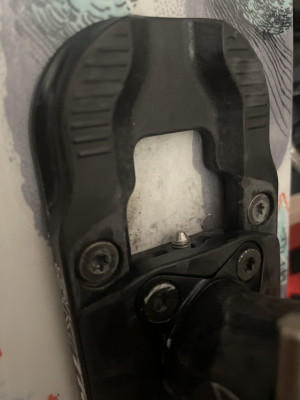Ski Trab Titan Vario.2 Binding
The original Ski Trab Titan Vario is spoken of in hushed and reverent tones here at Skimo Co, and the fact that many of our employees ski this binding for ~90% of their days each season is evidence of how much we liked the original version. If the original Titan Vario was the first Toy Story movie, then the Titan Vario.2 binding is Toy Story 2-- the rare sequel that lives up to the high standard set by the original. Since one pin can flex partially open without forcing the other side to open, the Titan toe pieces have an amazing retention profile. The heels received the lion's share of the makeover, and the now-gapless units are offered with three different fixed-release levels in the ranges of 5-7, 7-9, or 9-11. The housing rides on a spring which keep the release consistent, and the track this heel unit rides on is flexible in order to accommodate ski flex. The Vario.2 has a safety and performance profile heretofore unheard of in this category of lightweight bindings. Aside from an updated heel release mechanism, Ski Trab added a third riser that will be welcome on steep skin tracks or in deep snow-- just rotate the heel 180 degrees and voilà, the tall boy is ready to go. Making changes to a product that had such few flaws is a risky game, but in the case of the Ski Trab Titan Vario.2, the gamble paid off big time.
- A high-strength titanium spring in the toe provides independent clamping on each side, decreasing the chances of pre-release.
- A short and flexible heel plate keeps the alterations to the flex of the ski at a minimum, preserving safety as well as performance.
- First heel riser is a race-flap, making it quick to deploy while keeping a higher option available with a simple twist.
- A fast and simple ski crampon attachment point on the back of the toe unit will feel very familiar to avid backcountry skiers.
- Gapless heel pin design means the release values remain more consistent throughout the flex of the ski.
- The titanium spring in the toe piece is durable and simple, with fewer moving parts than a traditional tech toe piece.
- Elasticity in both the toe and heel pieces absorbs impact from bumps while offering superior retention characteristics.
- Optional brakes mounted under the heels feature an innovative anti-friction mechanism that won't interfere with the release.
- Stepping into the binding is the same as before-- just press down on the toe lever with your pole and step in.
- The heel plate has a spring inside of it, providing 8mm of elasticity to account for ski flex.
- Roto-riveted toe pins clean the snow and debris from your boot fittings while you skin.
- Turn the heel housing 90 degrees for a functional flat mode for those long approaches.
- With 24mm of heel adjustment along the plate, you can accommodate a quiver of boots.
- While not adjustable*, three spring strengths are available to accommodate most skiers.
* Contrary to what the listed ranges might imply, this binding does not have adjustable release settings. Uniquely, Ski Trab provides a range of skier chart values that each fixed-spring set is targeting (both the internal lateral springs and the replaceable vertical U-springs vary in tension). The release has been testing towards the high end of the range, so round down if you're on the border (e.g. choose 7-9 if you're a 9).
Update 2022/23: Ski Trab added an anodized red option so your bindings can reflect your emotion when someone boots in the skin track.
| Specifications | |
|
Weight |
254g [7-9] |
| Weight (pair) | 508g [7-9] |
|
Boot |
Tech |
|
Brakes |
Accessory 78, 85, 94 |
|
BSL |
24mm |
|
Riser |
2 + Flat |
|
Vertical |
5-7, 7-9 or 9-11 |
|
Lateral |
5-7, 7-9 or 9-11 |
|
Crampon |
Included Option |
| Specs Verified | Yes |
| Design | |
|
|
Titanium toe bar, Ergal aluminum frame, steel pins |
| Skimo Co Says | |
| Usage | Ski touring, training, mountaineering |
| Notes | Gapless heel keeps the release consistent while the ski is flexing |
| Bottom Line | Unmatched combo of performance, retention, and weight |
| Compare to other Lean Bindings | |
Related Products
Questions & Reviews
Do you have any suggestions?
We also have a binding finder form here, fill that out and we can get you some personalized recommendations!
If having multiple easily-accessible heel risers is important to you (i.e. not having to bend over and rotate the heel piece), then this heel piece isn't for you. But if you're only using the flat or high setting occasionally and mostly treating it like a race binding, it's fine.
On the downhill, the elasticity and retention are excellent. I never worry about these pre-releasing on me, and I have released when needed. I like having them on powder skis where you might compress the ski more on landings or when skiing faster. They feel slightly damper than the Gara Titan to me, but that's splitting hairs - mostly, I choose them for the peace of mind of having more elastic travel in the heel to absorb compressions and impacts, and to make pre-release even more unlikely. I do wish that the delta was slightly lower, maybe closer to +5-6mm, like a Gara Titan on a plate. But I can live with +8.5mm.
Only thing I’d change is to have some kind of wedge in the heel to clear snow from under boot heel when in flat mode. Does pack up when in fresh snow and in flat mode.
I guess there might be directions somewhere and maybe I’m dumb but it took me a second to figure out there are two clicks to lock it for touring. I found if you don’t lock out (second click) it releases pretty easy on steep touring. Also I’m assuming the first click is a ski mode..? Someone said the plastic out front is Mickey Mouse which I didn’t have problems with it but could definitely see it breaking.
The heel. I’m not smart enough to know about all the features. It skis great and is still plenty lean for recreational use. Drove my Locator 112s perfectly in everything from deep powder to groomers. My beef is the heel riser requires you to spin the heel from flat mode and the high riser seems low and can spin on you (only happened twice in 6 days of touring). The flip lever is over the pins which might save some time if your competing or lapping and want to steal all the fresh lines but not ideal for us lowly ski touring enthusiasts who aren’t psychopaths. Having to lunge down and spin your heel is the worst and inefficient on energy to say the least. If they fix that I would be 5 stars. That being said I’m glad I have this binding and not thinking about changing this setup at all.
The toe lever is plastic and I've had one break on me. They also get beat up by your pole tip and it's possible to over-rotate them out of alignment with the toe piece. It's easy to carry a spare but it seems like if ATK made this binding it'd be aluminum and wouldn't have those problems...
Otherwise it's a fantastic binding - light for a non-race binding, consistent release, no possible way to ice up the toe piece unlike nearly every other binding and simple operation. I typically just leave it in the low riser setting with the flap over the pins then flip the flap for quick skis-on skimo style transitions. The high riser and flat mode are accessed by rotating the whole rear piece 180 degrees and reaching down behind your heel is bit annoying but I rarely use those.
These bindings are on my Hyperchargers (106 waist) and Blacklight 88's and work great for both skis. I recommend these to all my friends as "this weird italian binding" - so far no takers but it takes time.
This Trab heel appears to be shorter than the R01. Are the widths the same?
I'm wondering if I can reuse at least one set of holes if I make the switch.
Also, does the toe piece have the same mounting pattern as the ATK Trofeo / Haute Route / RT10? I believe those all share the same toe piece dimensions. I think the Carbon C-Raider has a different mounting pattern.
Thank you!
You can compare all these dimensions using our reference articles on mounting patterns and adjustment plates.
I appreciate the information and reply. I'll ponder my next move.
In other words, swapping to a Titan heel from my Trofeo/Haute Route heel with R01 plate was a lateral shift and not what I was after.
I did not want to have to put another set of holes in this ski. Thanks!
I am a big fan of this binding. I have about 22 days on this ski, one in spring slush, and 21 in cold winter conditions.
I am 6', 166lbs, usually carried a 15-30lb pack. I bought this binding new in the 5-7 release setting.
The performance of this binding impresses me. For reference, I spent a season, about 30 days on an ATK Freeraider 14, dialed down to setting of 8, on some DPS C2s in 184cm length. It was a lot of fun, but there were a few times when I was bouncing over some wind chop and zastrugis, and a binding would prerelease. I thought that binding was one of the better freeride touring bindings. Since switching to the SkiTrab bindings, I have bounced over plenty of rough and rougher spots, and have yet to have a binding erroneously release. In my limited experience the SkiTrab bindings have the best retention of all the pin bindings. The weight to feature ratio of this binding seams unmatched.
I rarely would lock the toe when skinning. I never felt the need to lock the toe for the descent and thus never have.
I have never had icing issues with this binding, on ski traverses up to 7 days in length.
The rear piece worked well. I wish they would pare it down a little to shave weight.
This and the Gara are the only bindings I take into the backcountry, and the only pin bindings I trust. This may not be the most aesthetic binding, but it's performance at this weight seems to be years ahead of other manufacturers.
https://www.youtube.com/watch?v=U6kMo-jQLKY
Can you tell me if you have any major concerns with this setup? Or maybe explain the limitations of what I have here? Thanks.
Pros:
-best toepiece on the market
-incredible release and retention = confidence while skiing with toes unlocked
-relatively light
-zero durability issues after 100+ days of hard skiing
Cons:
-doesn’t have the same heel as Vario 1.0 (simpler, lighter)
-if it is going to have a heavier, “gapless” heel, then I think it should also have free-spinning pins (no U-spring) and perhaps a second riser option.
-I don’t like how the BSL adjustment screw sticks out when the heel is adjusted to the rear. (Looks weird and seems to attract ice)
The Vario.2 typically releases around the upper number of the range, so I'd recommend the 5-7.
A Vario.2 on a Free 107 couldn't be described as anything other than beautiful!
Use case would be mainly gate access sidecountry steep and deep stuff.
I love ‘em on my blacklight 88s. Is this a bridge too far?
Despite the light-looking design, the base plate is actually quite wide, lending this binding well towards skiing wide skis, at least as far as lightweight touring bindings go. Only thing to note is that you'll probably need to add brakes for resort skiing.
Pretty weird question here, but I'm wondering about mixing and matching this binding with an ATK freeraider. Basically, I just bought a second-hand pair of skis with the Titan vario 2.0, but the heel piece needs to be moved to fit my boot. These are Moment Deathwish Tour. I also bought a new, skinnier set, the Salomon MTN Carbon 96 (bit of a gamble, not much word out there on these yet!) and caught a deal on some freeraiders.
Since I need to re-drill the larger set of skis, and I'll really only ever use them on deep days, I was thinking I might also use them in-bounds occasionally. Hence, considering putting the freeraider heel on those with the TV2 toe for potentially slightlier better release characteristics. Then the FR14 toe with TV2 heel on the Salomons.
Will that work? Is it dumb? Open to all suggestions and advice, thanks all.
Will
Earn store credit by writing reviews. Learn more.






